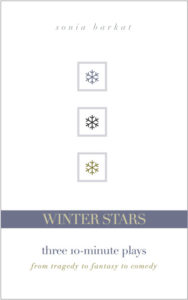Sometime in the past six years, I began to read contemporary plays. It may have started with a play we saw at the Hampstead Theatre in London, a dramatic comedy entitled Seminar written by Theresa Rebeck. (The attraction was actor Roger Allam, who plays the young Inspector Morse’s boss in the Masterpiece Mystery series Endeavour.) It’s a play about writing, writers, and academic egos. The script was for sale in the theatre lobby, and on a whim, I bought it to read later.
I enjoyed the script so much that I started reading others. Three years later, I read The Ferryman by Jez Butterworth, about “The Troubles” in Northern Ireland, but this time before I saw the play. And I was glad I did — the thick Irish accents by the actors could at times confuse my American ears, but I knew the story. It helped — a lot. A more recent play where reading the script also helps is Will Arbery’s Heroes of the Fourth Turning.

Setting my own ignorance aside, I settled down and read Barkat’s plays. I discovered they tell very compact stories, with a few characters and a focused message. And I could easily visualize each on the stage.
In the title play, Winter Stars, a narrator explains a legend, that each year in summer and winter, the twins Holly King and Oak King fight. One kills the other, who then passes into the hands of the goddess of reincarnation, until the seasons change, and he returns. It is a natural cycle of the seasons, and it has worked like this from time immemorial.
But in this cycle, something else is happening. Oak King (summer) is arriving earlier, and Holly King (winter) is graying and aging earlier. “Each night,” says Holly King, “when I retreat into the holly leaves … into the snow and into the frost … it feels like I’m burning. As if I’ve laid in a river with hemlock in its waves. It keeps getting worse. But now … It’s never been this bad.” This isn’t the only change. The twins will fight, but the outcome will be different. The play becomes a metaphor for climate change.
To the Shadows We Return is set in New York City, in a small 1920s-style hotel. Reading it is something akin to reading a noir story. A guest checking into the hotel recognizes one hotel employee, who denies knowing her. But he tells another employee that he lied; she had seen him commit a crime. What he doesn’t know is that she has a purpose, and it isn’t to spend the night in the hotel.

Sonia Barkat
Auras in Suburbia is set in the 1950s, and it could be any suburb anywhere. A husband is more than suspicious of the gardener, believing he has ill intentions up to and including murder. He learns these perceptions from his crystals and the auras he sees around people. His wife thinks of his New Age activities as something faintly ridiculous; she’s more concerned about the garden party they’re hosting. And she’s invited the gardener to attend.
These are three very different plays, but each considers how much of our prejudices, experience, and beliefs are packed into relationships. In Winter Stars, ostensibly about climate change, the two main characters keep doing what they’ve always done because it’s what they understand they do, and change seems impossible. To the Shadows We Return explores how we can be haunted and influenced by the past. Auras in Suburbia tells a story of just how crazy we can be in how we understand people and our relationship to them.
Operating within the constraint of 10 minutes, the plays convey a sense of urgency. And Barkat succinctly utilizes a few characters and simple narratives to tell very powerful stories. I’d like to see what each would look like when produced for the stage.
Photo by Noriaki Tanaka, Creative Commons, via Flickr. Post by Glynn Young.
__________________________

“I require all our incoming poetry students—in the MFA I direct—to buy and read this book.”
—Jeanetta Calhoun Mish
- Longfellow’s “Paul Revere’s Ride”: Creating a National Legend - April 17, 2025
- Poets and Poems: Katie Kalisz and “Flu Season” - April 15, 2025
- Poets and Poems: Michelle Ortega and “When You Ask Me, Why Paris?” - April 10, 2025

Bethany R. says
Interesting to think about reading plays in general and these ones in particular. As far as students go, what grades might this be suitable for (give or take)?
Thinking back to past TSP Twitter poetry parties, I remember Sonia Barkat’s writing as fresh and stunning. If that was what she was coming up with on the fly (truly take-a-step-back kind of lines), I’m sure a whole book of her words would be quite the read. 🙂 Thanks for this review.
Glynn says
I think the plays here would be good for the high school level and beyond.